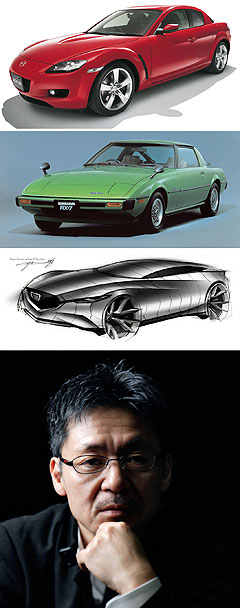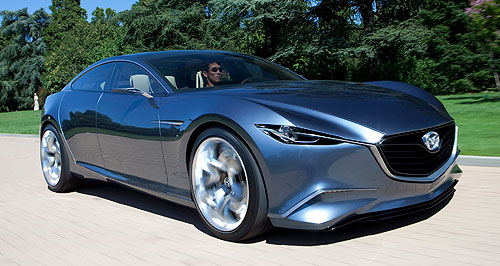Future models - Mazda - RX-9Mazda 'Sky Rotary' locked inStyle centre: Mazda's Shinari concept points the way to the company's next generation, but it won't necessarily get rotary power. Rotary power on the way ... and RX-7 firmly on Mazda designer's wishlist too7 Sep 2010 MAZDA has set an ambitious 50 per cent fuel consumption reduction target for its next-generation ‘Sky Rotary’ engine, but don’t expect it to power a showroom version of the sleek new Shinari four-door coupe concept any time soon. Before presenting its new ‘Kodo’ design language on the Shinari concept in Milan last week, Mazda offered selected global media – including GoAuto – an early taste-test of its ground-breaking new chassis and ‘Sky’ powertrain technologies in Berlin, where senior executives also reaffirmed their commitment to the Japanese car-maker’s trademark rotary engine. Mazda’s director of R&D and program management Seita Kanai declined to offer specific details of the company’s next-generation rotary engine (or what model it might power), but said it would wear the same Sky name as Mazda’s upcoming four-cylinder petrol and diesel engines – if Mazda can extract similar fuel-efficiency to the Sky G petrol four, which employs direct fuel-injection and a 14:1 compression ratio to return just 6.0L/100km in 2.0-litre form. “Today we cannot name it this, but a Sky rotary engine is under development,” Mr Kanai told Australian journalists in Germany. “We are not aiming for a small improvement. Fuel economy is our handicap, so we must drastically improve otherwise the next generation rotary cannot survive. But there is potentially a very large improvement available therefore it is important that we do this.”  From top: Mazda RX-8, Mazda RX-7, Mazda Shinari concept, Mazda design chief Ikou Maeda. From top: Mazda RX-8, Mazda RX-7, Mazda Shinari concept, Mazda design chief Ikou Maeda.Mr Kanai said the rotary engine would continue to provide a point of difference for Mazda and indicated that many features of the new Sky G petrol engine could also be applied to the rotary architecture to improve its efficiency. He would not comment on reports that Mazda is testing a version boosted by an electric supercharger, but indicated his engineers were starting from a clean-sheet design by going “very deeply back into the basic design of rotary”. “There are a lot of studies for the rotary,” said Mazda’s global R&D chief, adding that the company had achieved a miracle of sorts by keeping the rotary alive and that he hoped to “carry on that miracle” by developing a Sky version to match the efficiency of the Sky G. “That is my intention”, he said. “It’s very important for Mazda. The rotary is a gem for us so if we polish it, it will shine more ... and we are the only ones who know how to polish it. There are perhaps millions of engineers working on refining (conventional) engines ... we have perhaps only hundreds.” On sale in Australia since 2003, the four-door RX-8 sportscar is Mazda’s only current rotary-powered model, but has been criticised for returning V8-like fuel consumption of 12.1L/100km for the 158kW/211Nm automatic version and 12.9L/100km for the more popular manual model, whose 1.3-litre twin-rotor engine delivers 170kW. Mazda says that, contrary to reports, it has no plans to discontinue the RX-8 in Australia and Japan after it was axed in some overseas markets due to tighter Euro 5 emissions standards. The company has committed to reducing the average fuel consumption across its entire new-vehicle fleet – and therefore all future models – by at least 30 per cent between 2008 and 2015, but it remains unclear what type of model Mazda’s next-generation rotary engine will power. Mazda’s global product planning and powertrain development chief, Kiyoshi Fujiwara, told GoAuto that he recently approved the fourth-generation MX-5convertible for production, but a replacement for the eight-year-old RX-8 is more likely to debut the frugal new Sky rotary. Officially, the large four-seat, four-door Shinari sports coupe concept – which won’t appear at the green-focussed Paris motor show late this month – represents “a pure expression” of Mazda’s new Kodo design theme “in its idealised form”. Mazda has promised to include several of the show car’s striking new styling elements on redesigned production models – most likely starting with the new Mazda6 in late 2012. But it’s unlikely the Shinari’s striking new body design will translate directly on to production successors for either the four-door/four-seat RX-8 or Mazda’s original two-door/two-seat RX-7, a modern-day replacement for which would most likely be badged as an RX-9. Mazda is expected to continue with the rear-hinged ‘Freestyle’ rear door concept of the current RX-8, which continues to represent a unique selling point amid a growing number of conceptually similar models from luxury brands including Maserati, Mercedes-Benz, Aston Martin, Porsche and even Lamborghini. Beyond a next-gen RX-8, however, Mazda’s global design chief Ikou Maeda – who styled the RX-8 – said it would be “a dream come true” for him to design a new-generation RX-7, and told journalists to encourage Mazda to develop a successor for a hallowed model line first designed by his father, former Mazda design chief Matasaburo Maeda. But he cautioned that, apart from being the subject of the question he was most commonly asked, such a model was not yet on Mazda’s drawing board and remained “years away” from reality. “Please push Mazda ... please ask Mazda president to build other sportscar,” Mr Maeda told Australian journalists in Italy. “I have made a lot a sketches myself of the (RX-7) sportscar, but there is no program. Every time I talk to journalists the article always says the new RX-7 will debut in a couple of years. Please do not do this,” he implored. “If the market trend will be changed and a lot of people want to have it then we can build (it). A lot of young people don’t care about sportscars – not in Australia, your country is fantastic, but in Japan young people want computers …“That is why we built this car, to show what we can do.” Mr Maeda said any replacement for the RX-7 should be “much more serious” than both the original RX-7 and upcoming FT-86 concept-based sports coupes from Toyota and Subaru. “Maybe we are not following that (FT-86) direction, but if we have a chance to build a sportscar it will be much more genuine and serious. “Such a car should be lightweight and compressed ... and strong handling. It should not just be built to appeal to young trendy people but proper sportscar enthusiasts,” he said, adding that he would not enlist his father’s help to design a 21st century RX-7. “His tastes and my tastes on design are totally opposite,” he said. “He is a very functional guy and I want to make it much more enthusiastic.” Mr Maeda said the Kodo design language of the Shinari, which he said was “designed to talk freely about design”, would find its way onto the next-generation MX-5, despite the fact the world’s most popular convertible has “its own history”. “I would like to keep this (Kodo design theme) as much as possible,” he said. “But also the MX-5 has its own design language, so we will not adopt this design completely. We have to incorporate two things at once but not all the elements.”  Read moreAll future models Alfa Romeo Alfa Romeo Abarth Abarth Audi Audi Aston Martin Aston Martin BMW BMW Bentley Bentley Chrysler Chrysler Chevrolet Chevrolet Dodge Dodge Citroen Citroen Ferrari Ferrari DS DS Ford Ford Fiat Fiat FPV FPV Foton Foton Haval Haval Great Wall Great Wall Honda Honda Holden Holden Hyundai Hyundai HSV HSV Isuzu Isuzu Infiniti Infiniti Jeep Jeep Jaguar Jaguar Lamborghini Lamborghini Kia Kia Lexus Lexus Land Rover Land Rover Mazda Mazda Maserati Maserati Mercedes-Benz Mercedes-Benz McLaren McLaren Mini Mini Nissan Nissan Mitsubishi Mitsubishi Peugeot Peugeot Opel Opel Proton Proton Porsche Porsche Renault Renault Ram Ram Saab Saab Rolls-Royce Rolls-Royce Smart Smart Skoda Skoda Subaru Subaru SsangYong SsangYong Tesla Tesla Suzuki Suzuki Toyota Toyota Volvo VolvoMotor industry news |
Click to shareMazda modelsResearch Mazda All future models Alfa Romeo Alfa Romeo Abarth Abarth Audi Audi Aston Martin Aston Martin BMW BMW Bentley Bentley Chrysler Chrysler Chevrolet Chevrolet Dodge Dodge Citroen Citroen Ferrari Ferrari DS DS Ford Ford Fiat Fiat FPV FPV Foton Foton Haval Haval Great Wall Great Wall Honda Honda Holden Holden Hyundai Hyundai HSV HSV Isuzu Isuzu Infiniti Infiniti Jeep Jeep Jaguar Jaguar Lamborghini Lamborghini Kia Kia Lexus Lexus Land Rover Land Rover Mazda Mazda Maserati Maserati Mercedes-Benz Mercedes-Benz McLaren McLaren Mini Mini Nissan Nissan Mitsubishi Mitsubishi Peugeot Peugeot Opel Opel Proton Proton Porsche Porsche Renault Renault Ram Ram Saab Saab Rolls-Royce Rolls-Royce Smart Smart Skoda Skoda Subaru Subaru SsangYong SsangYong Tesla Tesla Suzuki Suzuki Toyota Toyota Volvo VolvoMotor industry news |
















Facebook Twitter Instagram